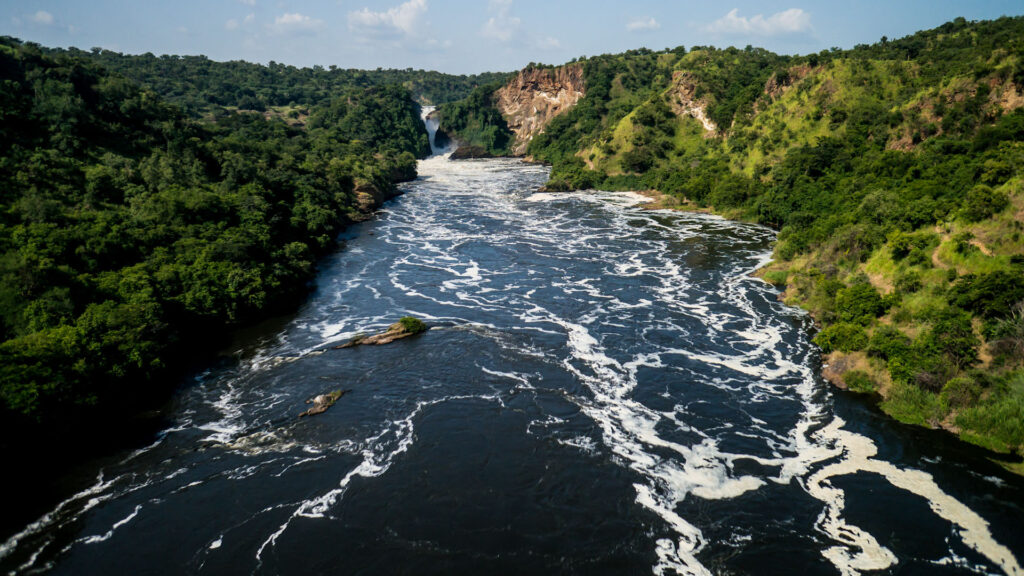Origin Of Nile River
The origin of the Nile River, one of the world’s most iconic and historically significant waterways, is a captivating tale that weaves through the heart of Africa.
This majestic river, renowned for its role in sustaining ancient civilizations, nurturing diverse ecosystems, and shaping the destiny of nations, finds its beginning in the highlands of East Africa. The Nile River’s origin is a convergence of two primary tributaries, the White Nile and the Blue Nile, each with its own distinct source and unique journey.

Together, they embark on a remarkable voyage, ultimately nourishing the fertile lands of Egypt before gracefully spilling into the Mediterranean Sea. In this exploration, we delve into the fascinating origins of the Nile River, tracing its life-giving waters from their remote, pristine beginnings to the legendary delta that has sustained humanity for millennia.
The Nile River is one of the world’s most famous and historically significant rivers, and its origin has been a subject of fascination for centuries.
The Nile has two main tributaries, the White Nile and the Blue Nile, which converge in Sudan’s capital, Khartoum, before flowing northward as the Nile River towards Egypt and eventually into the Mediterranean Sea.
The White Nile:
The longer of the two tributaries, the White Nile, is considered the primary source of the Nile River. It begins in Lake Victoria, which is located in East Africa and is shared by three countries: Uganda, Kenya, and Tanzania. From Lake Victoria, the White Nile flows northward through Uganda and South Sudan, eventually merging with the Blue Nile in Khartoum, Sudan.
Source in Lake Victoria:
The White Nile, often referred to simply as the “Nile,” is one of the two main tributaries that form the Nile River. Its journey begins at Lake Victoria, which is the largest lake in Africa and one of the largest freshwater lakes in the world.
Lake Victoria is located in East Africa and is bordered by three countries: Uganda to the west, Kenya to the northeast, and Tanzania to the south.
Flow from Lake Victoria:
From its source in Lake Victoria, the White Nile flows northward through Uganda, Sudan, and Egypt before reaching the Mediterranean Sea. As it exits Lake Victoria, it is a slow-moving river with a relatively gentle current.
Uganda:
In Uganda, the White Nile passes through several towns and cities, including Jinja. Jinja is famous for being the starting point of the Nile River’s great journey northward. It is also the location of the Bujagali Falls, which were submerged by the construction of the Bujagali Dam in the early 2010s.
South Sudan:
After leaving Uganda, the White Nile continues its journey into South Sudan. Here, the river’s course meanders through swamps and wetlands, making it less navigable than the Blue Nile, which flows through the Ethiopian highlands.
The Sudd, one of the largest wetlands in the world, is a prominent feature of the White Nile’s path in South Sudan.
Confluence in Khartoum, Sudan:
The most significant point in the White Nile’s journey is its confluence with the Blue Nile in Khartoum, the capital city of Sudan. At this point, the two rivers join to form the Nile River, which then flows northward through Sudan and eventually into Egypt.
Importance:
The White Nile, although often overshadowed by the more dramatic Blue Nile in terms of its origin in the Ethiopian highlands, carries a substantial amount of water.
It is a vital source of freshwater for the countries it traverses, providing water for agriculture, transportation, and the livelihoods of the people along its banks.
The Nile Delta in Egypt, where the combined Nile flows into the Mediterranean, is one of the most fertile and densely populated regions in Egypt, primarily due to the water supplied by both the White Nile and the Blue Nile.
The Blue Nile:
The Blue Nile, on the other hand, originates from Lake Tana in the Ethiopian highlands. Lake Tana is Ethiopia’s largest lake and is situated in the Amhara Region.
The Blue Nile flows westward from Lake Tana, cutting through the Ethiopian highlands in a series of dramatic waterfalls and gorges, the most famous of which is the Blue Nile Falls (also known as Tis Issat or the “Smoking Water”).
After leaving Ethiopia, the Blue Nile travels northward into Sudan, where it joins the White Nile in Khartoum.
Source in Lake Tana:
The Blue Nile, also known as the “Abay” in Amharic (Ethiopia’s official language), originates from Lake Tana. Lake Tana is the largest lake in Ethiopia and the largest in the Nile Basin. It is situated in the Amhara Region, in the northern part of the Ethiopian highlands.
Lake Tana is known for its rich biodiversity and cultural heritage, with numerous monasteries and historic sites located on its shores.
Flow from Lake Tana:
From its source in Lake Tana, the Blue Nile flows westward through the rugged Ethiopian highlands. This region is characterized by steep valleys, mountains, and deep gorges.
The Blue Nile’s course through this terrain gives rise to some of the most dramatic water features along its journey.
Blue Nile Falls (Tis Issat):
The most famous feature along the Blue Nile’s path in the Ethiopian highlands is the Blue Nile Falls, locally known as “Tis Issat,” which means “Smoking Water.”
These falls are often compared to the more well-known Victoria Falls in Africa, albeit on a smaller scale. The Blue Nile Falls are renowned for their beauty and the immense volume of water cascading over the falls during the rainy season.
Ethiopian Plateau:
As the Blue Nile flows through the Ethiopian highlands, it carves a path through the Ethiopian Plateau, creating deep canyons and gorges. The river’s passage through this terrain is marked by its erosive power, which has shaped the landscape over millions of years.
Entry into Sudan:
After leaving Ethiopia, the Blue Nile continues its journey northward, eventually entering Sudan. As it crosses into Sudan, it brings with it the water and sediment it has collected during its descent from the Ethiopian highlands.
Confluence in Khartoum, Sudan:
The Blue Nile’s journey culminates in Khartoum, the capital city of Sudan, where it converges with the White Nile. This confluence marks the official beginning of the Nile River.
The two rivers merge their waters and continue northward as the Nile, flowing through Sudan and Egypt before reaching the Mediterranean Sea.
The Blue Nile’s contribution to the Nile River’s flow is significant, especially during the rainy season when its waters are augmented by monsoon rains and the melting of snow in the Ethiopian highlands.
The fertile silt and sediment carried by the Blue Nile are vital for agriculture in the downstream regions, particularly in the Nile Delta in Egypt, where it helps replenish the soil and sustain crops.
The confluence of the White Nile and the Blue Nile in Khartoum marks the beginning of the Nile River proper. From there, the Nile flows north through Sudan and Egypt, supporting the livelihoods of millions of people along its course and playing a central role in the history and civilization of these countries.
The Nile Delta in Egypt is where the river fans out into a network of distributaries before finally emptying into the Mediterranean Sea.
The Nile River has been a lifeline for the people of Egypt for thousands of years, providing water for irrigation, transportation, and sustaining agriculture. Its annual flooding played a crucial role in the fertility of the Nile Valley, making it one of the cradles of civilization and the center of ancient Egyptian culture and history.


